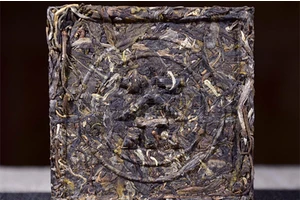China Yunnan Pu 'er Tea In 2024, an elephant in heaven and earth took root and 100 grams of 92 square brick raw tea.
Production of "92 square bricks" began in 1987, when it was an export product, and it was not until 1990 that it was exported to domestic market. The year with the highest output was in 1990, which just happened to catch up with the Asian Games, and the production of square bricks was the largest this year. Production of square bricks continued in 1991 and 1992. By 1993, because there was no new production plan, the square bricks in January 1993 were actually produced in 1992. The year 92 of "92 square brick" does not mean the year when production began, but the year when production of "92 square brick" ended.
At that time, raw materials with higher tenderness grade were required for export, so the 92 square brick broke the habit that good fresh leaves were used first to make high-grade green tea and black tea, and broke through the practice of suppressing brick tea with coarse and old raw materials. In addition, the long-term storage in the dry warehouse environment makes the "92 square brick" a model of orchid fragrance, and it is known as the "last tea king", and eventually becomes a classic product in the middle-aged and old Pu 'er Tibetan tea market. With the growing reputation of the "92 square brick", more and more pursuers are coming, which leads to the hard-to-find tea in the market and the rising price.
As early as 2003, Tiandiren Tea Factory also began to produce a batch of Pu 'er square teas. In 2024, Tiandiren Tea Factory paid tribute to the classics, selected high-quality arbor and tree spring teas as raw materials, and carefully pressed them with the classic formula of "square bricks", which made the classics reappear, and built an elephant "92 square bricks" with more than 30 years of tea-making skills and experience.
Quality characteristics:
Appearance: The buds on the surface of the tea brick are exposed, the appearance is square, elegant, compact and compact, the color is dark green, the strips are oily and plump.
Aroma: floral fragrance is elegant;
Taste: the entrance of tea soup is sweet and moist, full and mellow, with mellow taste, refreshing throat rhyme and quick tea flavor; The sides of the tongue are slightly astringent and melt quickly, and the bottom of the tongue springs; The aroma is progressive, the taste is layered, the aftertaste is endless, and the throat rhyme is long;
Soup color: yellow-green, clear and bright;
Leaf bottom: the leaf bottom is tender and soft;
Soup tasting:
Take 8 grams of tea, cover the bowl with 150ml, brew in boiling water, and wake up for about 10-15 seconds to get the soup;
Initial stage (1-3 bubbles): When the tea soup enters the mouth, it gives people a fresh feeling, gently slides over the tip of the tongue, bringing a little sweetness, and the taste is still light, but it can vaguely feel its inherent potential and spread leisurely on the tip of the tongue.
Middle stage (4-9 bubbles): continuous brewing, with the tea soup slowly flowing in the mouth, the taste gradually appears, and the soup feeling begins to become thick and full. This massiness is not dull or sticky, but contains a rich sense of hierarchy. The color of tea soup seems to be more and more rich, and the aroma and taste are progressive in the oral cavity, and the sweetness is more abundant, lingering in the oral cavity, leaving people with endless aftertaste and long throat rhyme;
The last stage (10-12 bubbles): Brew slowly to ten bubbles. Although the aroma is not as flamboyant as before, it is displayed in a more restrained way. The tail water is also sweet and the leaves are fat and soft.
Overall review:
92 square bricks, the soup color is yellow-green, clear and translucent; The flowers are fragrant and elegant; The entrance is sweet, delicate and slightly astringent; Jin Kuai Gan Jiu; Sweet and moist, full and smooth, mellow in taste, refreshing in throat rhyme and quick to show the smell of tea; Rich layering, long throat rhyme and endless aftertaste; The bottom of leaves is fat and soft.
Brewing method:
Tea dosage: Based on 150ml covered bowl, it is suggested that the dosage of tea should be 7 to 8 grams.
Tea-water ratio: it is suggested that the tea-water ratio is 1: 15, which can also be adjusted according to personal preference.
Water temperature: boiling water brewing.
Time: after moistening tea, it is advisable to brew for 5 ~ 10 seconds each time, which can be appropriately extended with the increase of brewing times.
产品详情






